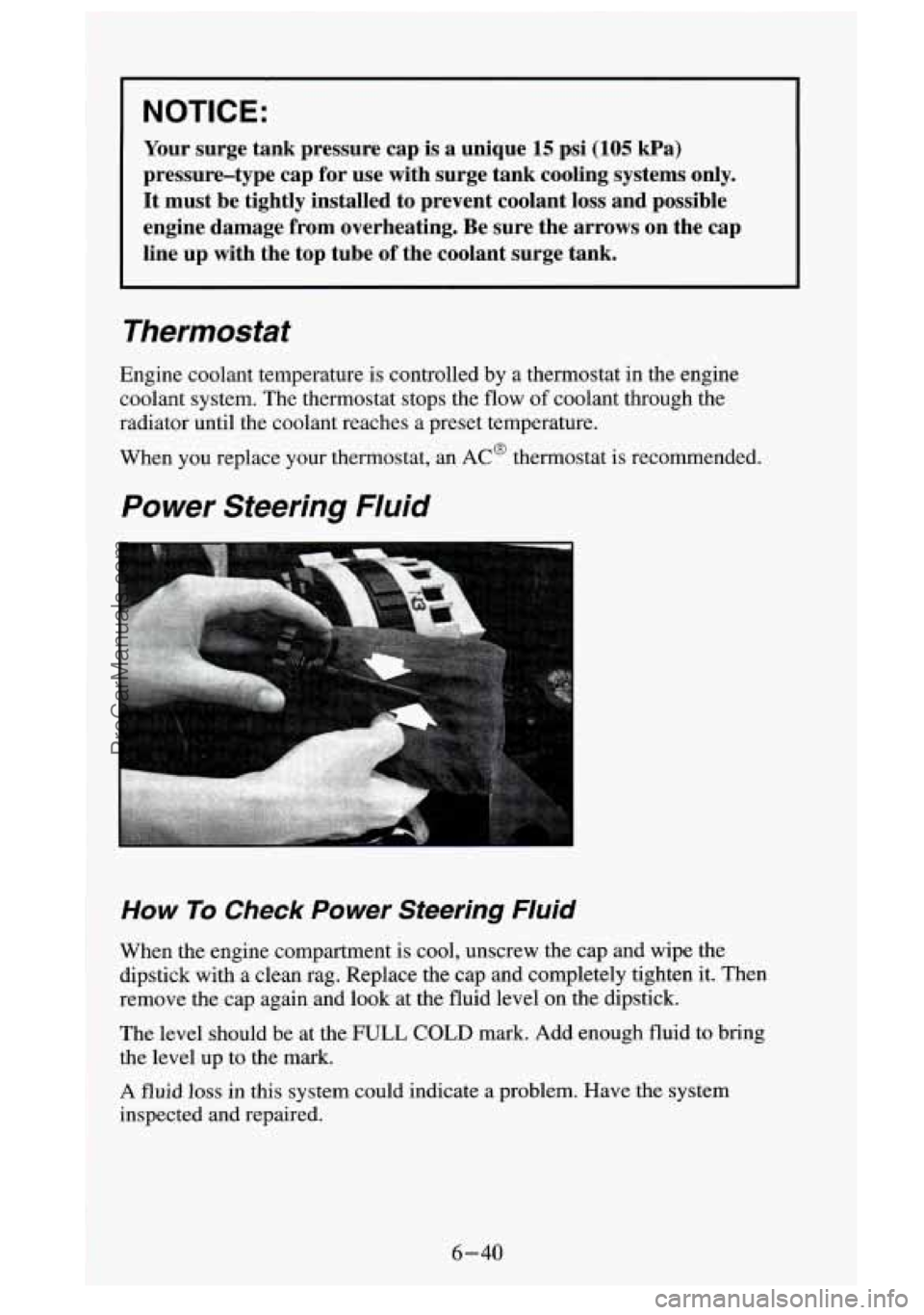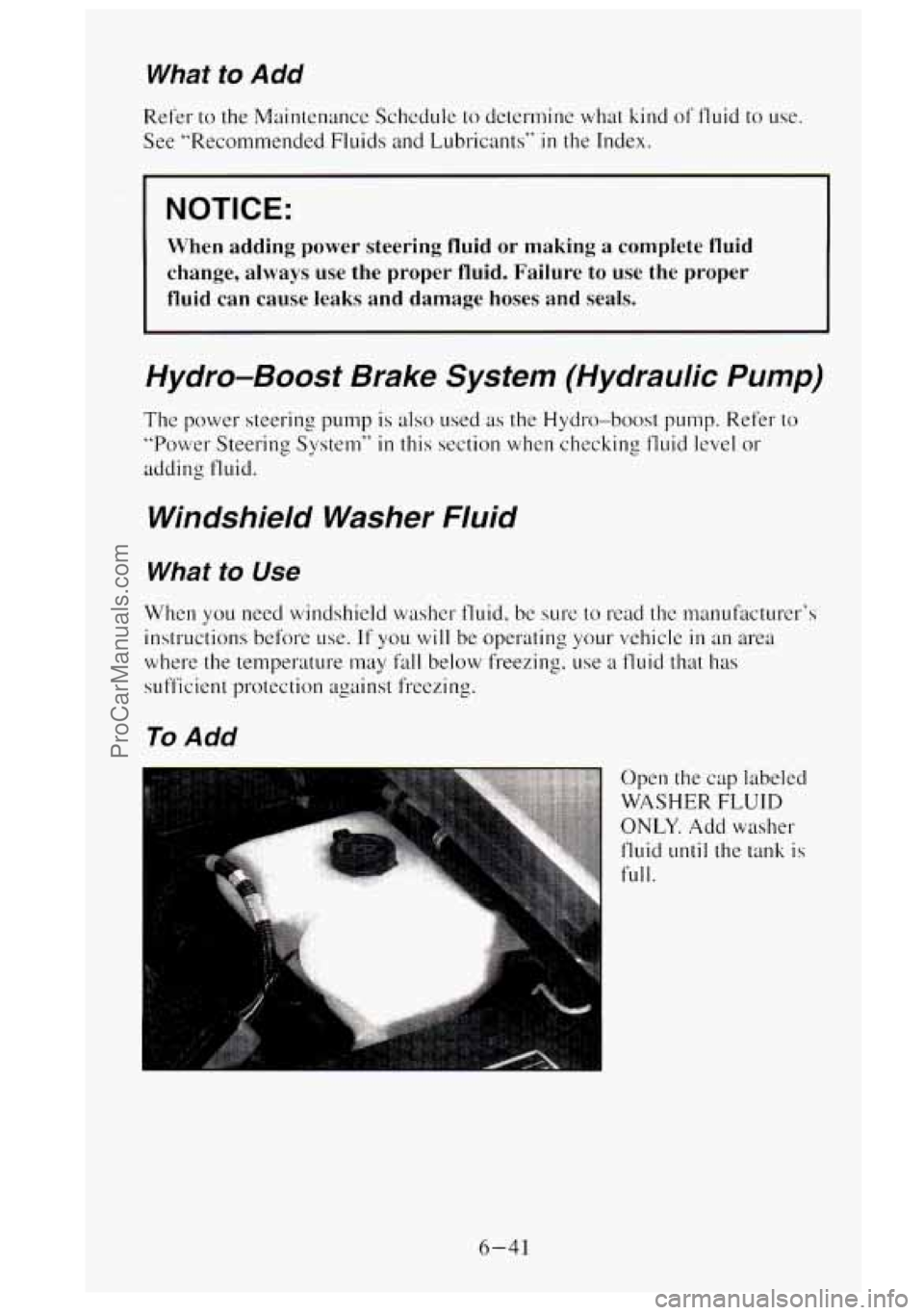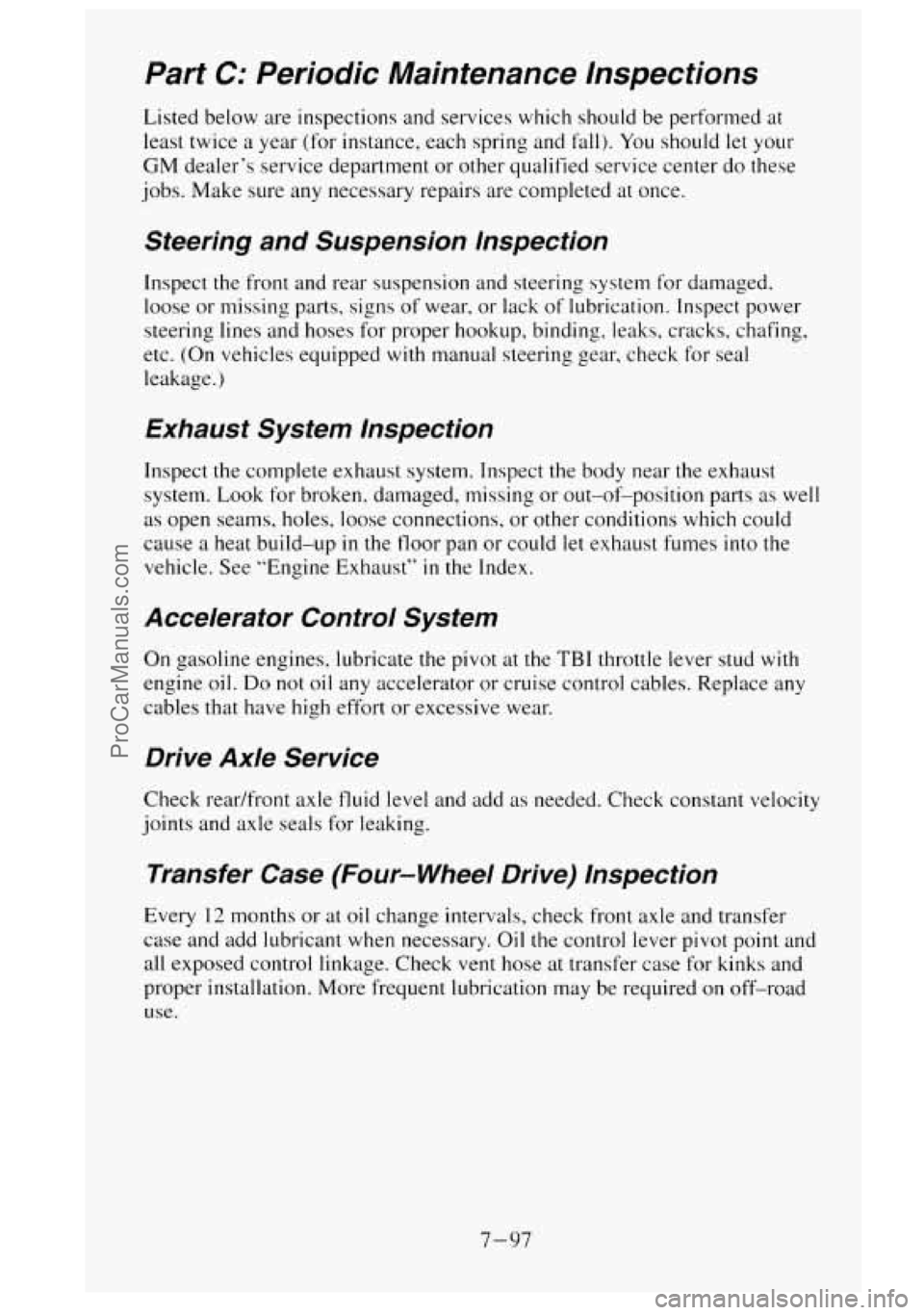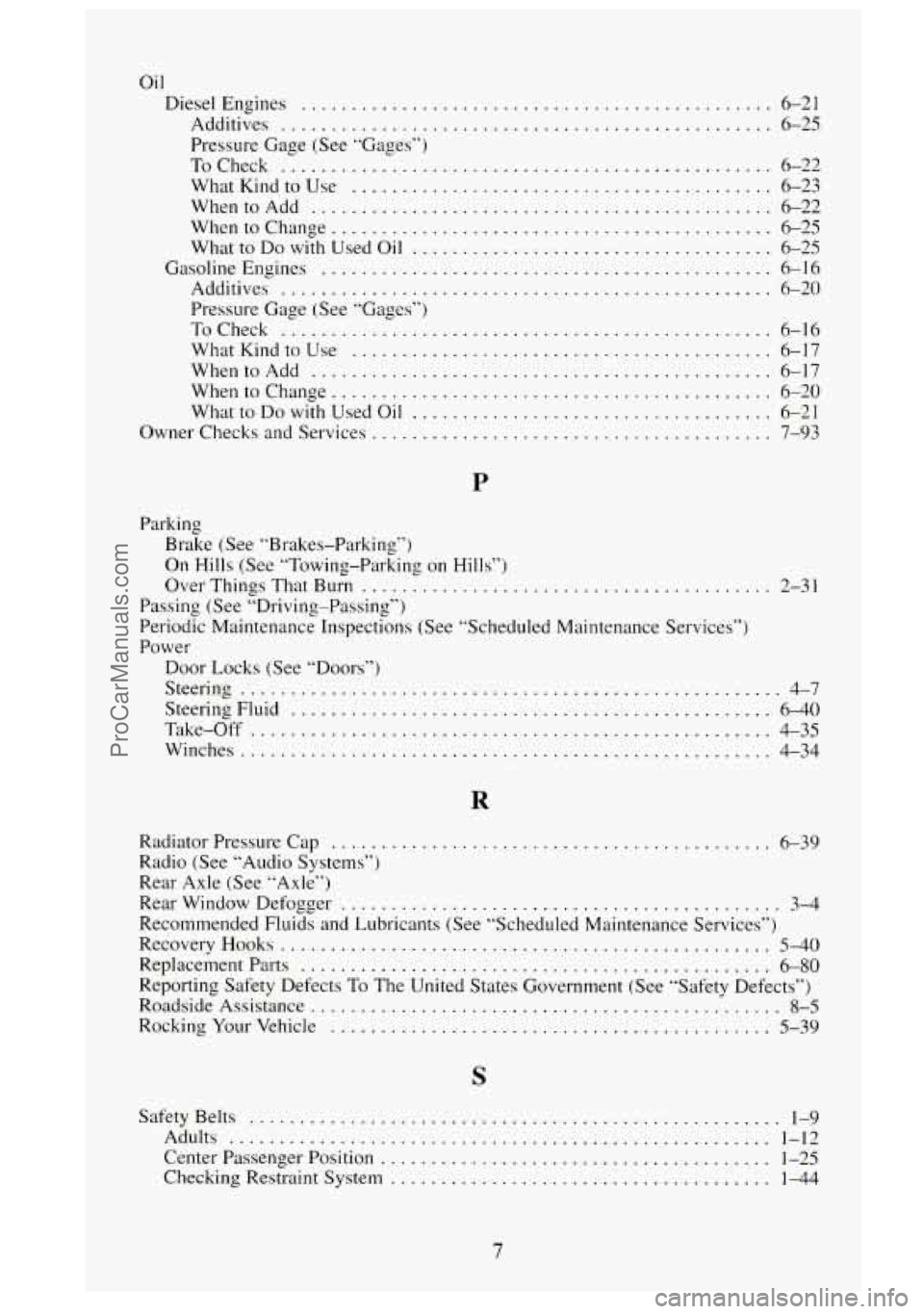1995 GMC SIERRA power steering fluid
[x] Cancel search: power steering fluidPage 306 of 488

NOTICE:
Your surge tank pressure cap is a unique 15 psi (105 kPa)
pressure-type cap for use with surge tank cooling systems only.
It must be tightly installed to prevent coolant loss and possible
engine damage from overheating. Be sure the arrows on the cap
line up with the top tube of the coolant surge tank.
Thermostat
Engine coolant temperature is controlled by a thermostat in the engine
coolant system. The thermostat stops the flow
of coolant through the
radiator until the coolant reaches a preset temperature.
When you replace your thermostat, an AC@ thermostat is recommended.
Power Steering Fluid
How To Check Power Steering Fluid
When the engine compartment is cool, unscrew the cap and wipe \
the
dipstick with a clean rag. Replace the cap and completely tighten it. Then
remove the cap again and look at the fluid level on the dips\
tick.
The level should be at the
FULL COLD mark. Add enough fluid to bring
the level
up to the mark.
A fluid loss in this system could indicate a problem. Have the system
inspected and repaired.
6-40
ProCarManuals.com
Page 307 of 488

What to Add
Refer to the Maintenance Schedule to determine what kind of' tluid to use
See "Recommended Fluids and Lubricants"
in the Index.
NOTICE:
When adding power steering fluid or making a complete fluid
change, always use the proper fluid. Failure to use
the proper
fluid can cause leaks and damage hoses and seals.
Hydro-Boost Brake System (Hydraulic Pump)
The power steering pump is also used as the Hydro-boost pump. Refer to
"Power Steering System''
in this section when checking fluid level or
adding fluid.
Windshield Washer Fluid
What to Use
When you need windshield washer fluid, be sure to read the manuhcturer's
instructions before use.
If you will be operating your vehicle in an area
where the temperature
may fall below freezing, use a fluid that has
sufficient protection against freezing.
To Add
Open the cap labeled
WASHER FLUID
ONLY. Add washer
fluid
until the tank is
full.
6-41
ProCarManuals.com
Page 453 of 488

Part C: Periodic Maintenance lnspections
Listed below are inspections and services which should be performed at
least twice a year (for instance, each spring and
fall). You should let your
GM dealer’s service department or other qualified service center do these
jobs. Make sure any necessary repairs are completed at once.
Steering and Suspension Inspection
Inspect the front and rear suspension and steering system for damaged.
loose or missing parts, signs of wear,
or lack of lubrication. Inspect power
steering lines and hoses for proper hookup, binding, leaks, cracks, chafing,
etc. (On vehicles equipped with manual steering gear, check for seal
leakage.)
Exhaust System Inspection
Inspect the complete exhaust system. Inspect the body near the exhaust
system.
Look for broken. damaged, missing or out-of-position parts as well
as open seams, holes, loose connections,
or other conditions which could
cause a heat build-up
in the floor pan or could let exhaust fumes into the
vehicle. See “Engine Exhaust”
in the Index.
Accelerator Control System
On gasoline engines. lubricate the pivot at the TBI throttle lever stud with
engine
oil. Do not oil any accelerator or cruise control cables. Replace any
cables that have high effort or excessive wear.
Drive Axle Service
Check readfront axle fluid level and add as needed. Check constant velocity
Joints and axle seals for leaking.
Transfer Case (Four- Wheel Drive) Inspection
Every 12 months or at oil change intervals, check front axle and transfer
case and add lubricant when necessary. Oil the control lever pivot point and
all exposed control linkage. Check vent hose at transfer case for kinks and
proper installation. More frequent lubrication may be required on off-road
use.
7-97
ProCarManuals.com
Page 455 of 488

USAGE
Power Steering System Manual Transmission (5-Speed
with Low Gear, RPO MT8)
Manual Transmission (5-Speed
without Low Gear, RPO MG5)
Automatic Transmission Key Lock Cylinders
FLUIDLUBRICANT
GM Power Steering Fluid (GM Part
No. 10500 I7 or equivalent).
Castrol Syntorq'
LT or equivalent
(GM Part No. 12346191
- 1 gal.)
(GM Part
No. I23461 90 - 1 qt.).
Synchromesh Transmission Fluid
(GM Part
No. 12345349 or equiva-
lent).
DEXR0N'-I11 Automauc
Transmission Fluid.
Lubricate
with Multi-Purpose Lu-
bricant (GM Part No. I2345 120) or
synthetic SAE SW-30 engine oil.
Automatic Transmission Shift
Linkage
Clutch Fork Ball Stud (5-Speed
with Low Gear)
Floor Shift Linkage
Chassis Lubrication
Front Wheel Bearings
Differential, Standard, Front and
Rear Axle
Differential, Locking
Transfer Case Engine
oil.
Chassis lubricant (GM Part
No.
12346003 or equivalent) or lubri-
cant meeting requirements of NLGI
Grade 2, Category LB or GC-LB.
Engine
oil.
Chassis lubricant (GM Part No.
I2346003 or equivalent) or lubri-
cant meeting requirements of NLGI
Grade
2, Category LB or GC-LB.
Wheel bearing lubricant meeting
requirements
of NLGI Grade 2,
Category GC or GC-LB (GM Part
No. I2346003 or equivalent).
Axle Lubricant (GM Part No.
105227
1 ) or SAE 8OW-90 GL-5
Gear Lubricant.
Axle Lubricant (GM Part
No.
105227 1) or SAE 80W-90 GL-5
Gear Lubricant.
DEXR0N"-111 Automatic
Transmission Fluid.
7-99
ProCarManuals.com
Page 479 of 488

Oil DieselEngines
............................................... 6-21
Additives
................................................. 6-25
Pressure Gage (See “Gages”
j
ToCheck ................................................. 6-22
WhatKindtoUse
.......................................... 6-23
WhentoAdd
.............................................. 6-22
WhentoChange
............................................ 6-25
What to Do with Used Oil
.................................... 6-25
Gasoline Engines
............................................. 6-16
Additives
................................................. 6-20
Pressure Gage (See “Gages”)
ToCheck
................................................. 6-16
WhatKindtoUse
.......................................... 6-17
WhentoAdd .............................................. 6-17
When to Change ............................................ 6-20
What to Do with Used
Oil .................................... 6-21
Owner Checks and Services
........................................ 7-93
Parking Brake (See “Brakes-Parking”)
On Hills (See “Towing-Parking on Hills’*j
Over Things That Burn
........................................
Passing (See “Drivin~-Passing”)
Periodic Maintenance Inspections (See “Scheduled Maintenance Services”)
Power
Door Locks (See “Dood’j 2-31
Steering
...................................................... 4-7
Steering Fluid
................................................ 640
Take-Off
.................................................... 4-35
Winches
..................................................... 4-34
Radiator Pressure Cap
............................................ 6-39
Radio (See “Audio Systems”)
Rear Axle (See ”Axle”)
Recommended Fluids and Lubricants (See “Scheduled Maintenance Services“)
Recovery Hooks
................................................. 5-40
Replacement Parts ............................................... 6-80
Reporting Safety Defects To The United States Government (See “Safety Defects”)
Roadside Assistance
............................................... 8-5
Rocking Your Vehicle ............................................ 5-39
Rear Window Defogger
............................................ 3-4
Safety Belts ..................................................... 1-9
Adults ...................................................... 1-12
Center Passenger Position ....................................... 1-25
Checking Restraint System ...................................... 1-44
7
ProCarManuals.com